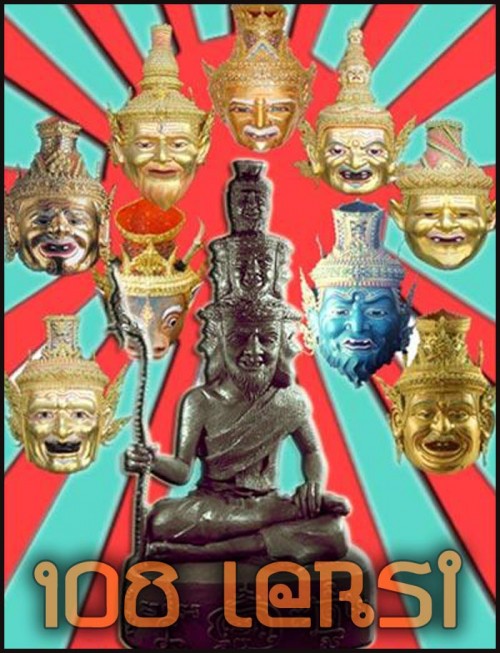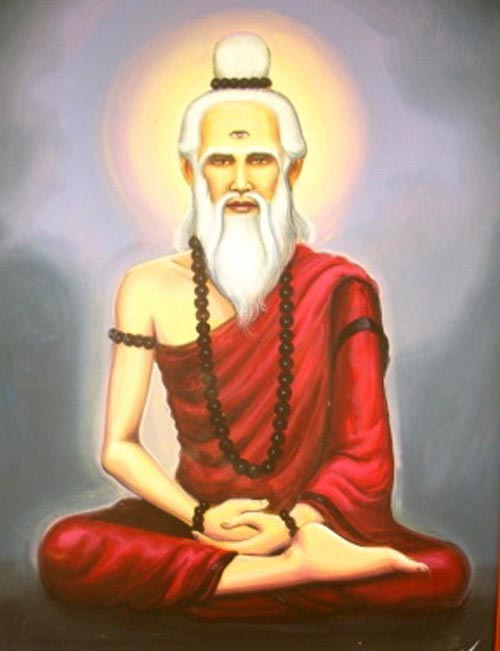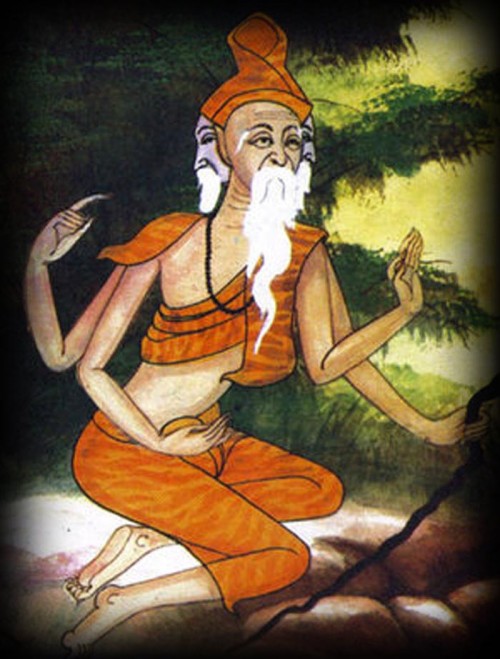The Lersi; The Ruesi, or ‘Pra Rasi’ – Also called in India, the “Rishi”
Lersi is a word used to call people who possess mind powers, who practice the development of mind and it’s powers in various aspects. Even the Lord Buddha Himself received teachings from the Lersi. All the different Lersi Hermit Sages are to be documented and added to this section.
Sidhatta only left the schooling philosophy of the Ruesi, because it wasn’t going to lead him to Enlightenment,rather only to a higher level of the heavenly realms, a favorable rebirth that leaves one reborn as an Angel or an Archangel Buchiwagoemarapat was the healing Master Ruesi who served as doctor to the Buddha Sakyamuni.
The Ruesi are known to have attained various supernatural mind powers, such as;
The Ability to Float and See the Future, Heal with Forest Herbs, Voice Powers (Incantation and Prana), talk with animals, read minds, and even Teleportation, Manipulation of the Elements, Alchemy and other Miraculous forms of Mastery of the Environment.
Another translation for the word Ruesi, would be “Seer” -the author suggests also the word Wizard, as the Ruesi also made use of Magic Spells using a stick to cast with,just as does the Wizard who is to be found in Western Mythologies.
The word Ruesi is associated with the thought of a secretive, mysterious hermit-like person who lives a solitary existence and dwells in a cave, the forest or in the mountains. The real meaning of the word Ruesi, is “Seer”, meaning one with special abilities to see things that normal humans cannot perceive, such as vision of the three times (Past, Present & Future events).
Such an ability is called Trigalachan, meaning “he who knows the three time spheres. the oldest Sanskrit Myths and texts do not record how far back the existence of the Ruesi goes, but the Buddhist texts have a record known referring to the Buppaeniwaasaanusathiyan – of the Ruesi and that of the Buddha, and how they differ (Buppaeniwaasaanusathiyan means the ability to remember previous incarnations).
Ruesi can allegedly only remember up to a limit of eighty past lives, whereas the Buddha could remember as far back as it is possible to imagine, an endless number of lives that cannot be counted.This text also heralds the Buddha as being the superior Being and much higher than any Ruesi. There is a comment in the Thaera Kata of the Khuttaga Nigay saying “The Great Lord Buddha is the Ruesi who is most perfect and attained of all the Ruesi”. Therefore suggesting that the Buddha was also a Ruesi, albeit the most highest of all. The creation of the great “Ruekawaes” (Rigveda) 500 years ago, was accredited to the Ruesi.
Lord Shiva, in fact was also a Ruesi.
There are four main Categories for Ruesi, where each of the four types have differing qualities;
* 1.Racharuesi * 2.Prahmaruesi * 3.Taewaruesi/Tepruesi * 4.Maharuesi
RACHA LERSI;
the first and lowest class, exist under the normal rules of Nature and don’tt posess any special powers that normal humans do not posess.
The only differ in the fact that they are beginning to attempt to practise the laws of the Ruesi and open one’s mind.
PROHM LERSI;
This class of Ruesi may attain a rebirth as a Prahma, which are Angelic Beings of the Higher Heavenly Realms.
TAEP LERSI;
This Ruesi class have practised industriously their vows and have attained enough merit to recieve supernatural abilities and Incredibly strong powers.
MAHA LERSI;
Apart form having attained the aforementioned special powers, this class of Ruesi have an incredible intelligence, and extremely powerful Magical spells
Magic is intensely present in such kind of Ruesi. There is a further dividing of these four categories of Ruesi into eight other types. They are listed as such;
* Pra Sitaa * Pra Yokii (Yogi) * Pra Munii * Pra Dabos (Dabasa) * Chadin (Chadila) * Nak Sit * Nak Prot (Paratha) * Prahm (Brahma)
A Ruesi who manages to incorporate all the qualities of these eight types of Ruesi, is then considered to be “Samrej” (completely developed). Such a Ruesi will have revoked all self centered thought, and has freed himself from all worldly attachments. This kind of Ruesi will see the nature of reality with his eyes closed, he will have complete “Sila” (ascetic vows), know what actions are meritorious and which are causes of negative results.
He understands the laws of karma completely and acts wisely in accordance, and therefore develops no negative causes/effects in his future existences.This eightfold Ruesi will have passed the Sodaban level of consciousness, have divine mind, eyes and ears.This is the meaning of “Samrej”. In the life immediately following this incarnation, the Ruesi will be reborn in the “Prohm” (Brahma) level of the heaven (in the west we refer to this as seventh heaven – the phrase is obviously originating from the Hindu Vedas and Buddhist texts, as this is the seventh level of heaven.
In this level of Heaven, there is no suffering, and the beings there partake of pleasure and peaceful existence. But this is not the end of the journey for such a being – the Ruesi will then continue his/her spiritual and mental development to rise even further to higher levels and beyond the realms of our imagination.
The meaning of each of the 8 types of special Ruesi is as follows;
- Pra Sita – means a Ruesi who has special qualities of goodness and ethical values. Such a Ruesi will abide in mountain ranges, and caves that may be found therein, this place between the sun and the earth (mountains) is where he finds it comfortable to live.
- Pra Yokii means “he who is in completion”, or a practicant of “Sangyoke” (Yoga). This kind of Ruesi will wander in the forest or mountains leading a solitary existence refusing all comforts and putting himself/herself through various trials and sufferings in order to attain a higher consciousness.
- Pra Muni means “one of the Brahmin group who is maintaining extreme effort to acheive spiritual/magickal accomplishments. Pra Muni Ruesi will achieve a high level of wisdom, knowledge and abilities through their diligent study and practice. This Ruesi is of the intellectual variety.
- Pra Dabos (Dabasa) means “he who practices self control and actions to accomplish great merit”. This type of Ruesi maintains an effort to cut the cords of selfishness and attachment (Kilesa) through self infliction of renunciation of pleasures and undergoing physical and mental hardships (self torture) in order to enter the world of bliss that is the result of meritorious action through self denial and renunciation of worldly pleasures.
- Chadin (Chadila) a Ruesi who likes to wind his hair up in a mound on top of his head (like the “Babas” you can observe in India to this day). Their beards and mustaches are unruly, uncombed and rather uncared for.These Ruesi do not like a cleanly orderly life – they wander around in the forests and outbacks.They are considered to be Brahmins.
- Nak Sit (Siddhi) means a half Angelic (Divine) half Human being, that has “Sila” (spiritual vows/vocational behaviour). These beings love truthful speech that leads to true understanding and knowledge.They have a deeply ingrained feeling for justice and righteousness, and like to lend help to people who have fallen into great hardship and suffering.They reside in open, pure and empty places, ranging from the sun and space right down to the human realms on this planet.There are many hundreds of thousands of these beings roaming around the heavens looking for entry points to come down to earth and help the Humans in distress (Bodhissattwa like beings indeed).
- Nak Prot means a Ruesi who keeps his vows of renunciation and “Sila” with great perseverance, never allowing himself to slip in his promise to keep the vows of purity.These beings like to reside in mountai caves, forests and places where magick herbs grow, they never let people see them and remain hidden from the eyes of Humans.
- Prahm (Brahman) means “Brahmin” a Brahman has a lot of similarity with Ruesi in any case. Disinterested in the world outside oneself, and belief in the necessity to go out and lend aid to Beings in distress and in need of help is central to their practices. Brahmins tend to reside and meet in groups in the vicinity of Divine and sacred places.When someone asks for a Brahmin to come and help to initiate a ceremony,whether it be a Ceremony for the Lersi, or Angelic beings or other Divinities, the Brahmin will come and set up the Ceremony at no cost or need of repayment in any manner (this is in the present day unfortunately not true anymore, the tradition has been destroyed by the modern society which has made it impossible to exist without the transfer of money). In brief, Brahmans love to help other beings in any way and when not in the service of living Beings, they return to their practice of renunciation of pleasures and keeping of vows of renunciation and purity (Sila).
Lersi in The Vedas
There are four Vedas, the Rig Veda, Sama Veda, Yajur Veda and Atharva Veda. The Vedas are the primary texts of Hinduism. They also had a vast influence on Buddhism, Jainism, and Sikhism. Traditionally the text of the Vedas was coeval with the universe. Scholars have determined that the Rig Veda, the oldest of the four Vedas, was composed about 1500 B.C., and codified about 600 B.C. It is unknown when it was finally committed to writing, but this probably was at some point after 300 B.C. The Vedas contain hymns, incantations, and rituals from ancient India. Along with the Book of the Dead, the Enuma Elish, the I Ching, and the Avesta, they are among the most ancient religious texts still in existence. Besides their spiritual value, they also give a unique view of everyday life in India four thousand years ago. The Vedas are also the most ancient extensive texts in an Indo-European language, and as such are invaluable in the study of comparative linguistics.
3500 to 5000 years ago, the Lersi composed texts, prayers, incantations and spells to invoke the Angelic beings. This was due to the fact that the Ruesi had practiced training their minds and raised their consciousness to the Samabhabhati level of Jhana. They could see things on higher planes that the normal human cannot, including being able to hear sounds from other dimensions that any normal person will never get to hear. This made listening to the Angelic Beings accessible. when a Ruesi enters meditation and Samadhi, he will naturally experience visions and sounds that are created for him as a communication means by the Angelic Being that wishes to communicate with him. The words in the texts of the Rigveda, however, are not the words invented by the Ruesi; they are the words given to the Ruesi by the Gods or Angelic Beings, as the Ruesi were in the meditative state.
Maybe the most important and sacred of all the scriptures and incantations written down as they were heard by the Ruesi whilst listening to the higher dimensional realms, is the “Srut”, meaning “That which was heard from the Deities”. This great work differs from the legends written by the Ruesi after the Vedas. The difference being, that the later books (known as Samarueti, meaning “that which was written from memory”), were not written as words that have been directly heard from the mouth of the deities, rather, the words are taken from what the first generation of Ruesi had already documented. The later texts therefore, are not directly transmitted.
Other Types of Lersi Classifications
Apart from the aforementioned 4 types of Lersi, there are many other Special subdivisions of Lersi, depending on local belief systems.These are divided into seven types and a further three are added to make ten. These were created by Pra Bprachaabadii
- Pra Koedom
- Pra Paratawaach
- Pra Wisawaamitr
- Prachomtasanii
- Pra Wasit
- Pra Gasop (Gasabpa)
- Pra Athri
- Ruesi Pra Bprajaetas
- Pra Parueku
- Pra Narot
Pra Gasop – common folk tend to think that Pra Gasop Ruesi is a ghostly/phantom-like being, which is a wrong view of this classification of Ruesi. Pra Gasop eventually became incarnated in the Human world, and is considered to have been the first ever Ruesi to have appeared in the realm of Human Beings.
Thai local villagers call them “Phee” (ghosts). If they were really ghosts, then they would have a lower status like the Asuras (monsters/jealous gods). This Lersi Sage was first created by the Divinity Brahma in the same phase as he created the Asura beings.


